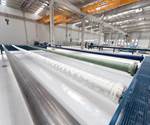5G-enabled smart cities bring opportunities for pultruded composites
A recent report explores the utility of radio frequency-transparent pultruded composite materials for integrating 5G mobile networks into urban infrastructure.

Source | Pixabay via EPTA
Transparency to radio frequency (RF) signals is reported to be an emerging factor in favor of composites adoption in urban infrastructure, according to a recently released industry report from the European Pultrusion Technology Association (EPTA, Frankfurt, Germany). The report, “An expanded role for pultruded composites in 5G cities,” outlines how the rollout of 5G mobile networks in cities will drive increased adoption of composite materials in urban infrastructure.
According to the EPTA, 5G mobile network services are expected to be widely available by 2025, with the purpose of integrating digital and data-driven solutions for more efficient operation of growing urban areas. To accommodate this, a dense network of 5G small cells — which are low-power micro base stations, or cell towers, which transmit and receive high-frequency 5G signals locally — will be installed into cities’ infrastructure, creating a need for 5G radomes, base stations and antenna shrouds built using RF-transparent materials.
EPTA says that composites will be key, as pultruded glass fiber composite profiles, often used in telecommunications already, are almost “invisible” to RF waves. Different fibers and resins can be combined to deliver a range of dielectric properties suitable for various end-use applications, and EPTA says developments are targeting lower dielectric constants and loss tangents to enable better performance with higher frequency signals.

“Smart” utility poles. Source | EPTA
The report also highlights a project to develop “connected light poles,” or “smart poles,” an emerging solution for 5G small cells that integrate energy-efficient LED lighting with interior space for 5G hardware and antennas from multiple OEMs in one pole. The LuxTurrim5G project on Smart City Digital Ecosystem Creation, driven by Nokia Bell Labs (New Providence, N.J., U.S.), is one initiative developing pultruded composite light poles with integrated miniaturized 5G antennas and base stations. As well as providing energy-efficient lighting, the poles will reportedly create a high-capacity 5G data transmission network and incorporate sensors, information displays, cameras and other devices in order to trial a variety of services and business concepts.
The LuxTurrim5G project partners are also comparing 5G signal loss through composite building elements with that through conventional building materials since short wavelength 5G signals have poor in-building penetration. Pultruded building elements such as window frames and doors, beams, panels and architectural facades are said to deliver improved in-building signal penetration as well as excellent thermal insulation.
“Composite materials offer many properties that make them attractive construction materials for future cities, including high strength and stiffness, low weight, corrosion resistance, thermal insulation and design freedom,” says Dr. Elmar Witten, secretary of EPTA. “The need to ensure reliable 5G coverage in buildings and outside brings additional motivation for the integration of RF-transparent pultruded composites into urban design.“
Related Content
-
SmartValves offer improvements over traditional vacuum bag ports
Developed to resolve tilting and close-off issues, SmartValves eliminate cutting through vacuum bags while offering reduced process time and maintenance.
-
From the CW Archives: Airbus A400M cargo door
The inaugural CW From the Archives revisits Sara Black’s 2007 story on out-of-autoclave infusion used to fabricate the massive composite upper cargo door for the Airbus A400M military airlifter.
-
Bladder-assisted compression molding derivative produces complex, autoclave-quality automotive parts
HP Composites’ AirPower technology enables high-rate CFRP roof production with 50% energy savings for the Maserati MC20.

.jpg;width=70;height=70;mode=crop)














